Garnet Characteristics Associated with Jiama Porphyry-Skarn Cu Deposit 1# Skarn Orebody, Tibet, Using Thermal Infrared Spectroscopy
Abstract
1. Introduction
2. Geological Setting
2.1. Deposit Geology
2.2. 1# Skarn Orebody
3. Methods and Samples
3.1. TIR Technique
3.2. EPMA Measurements
3.3. Cu and Mo Concentrations
4. Results
4.1. Spectral Characteristics of Garnet
4.1.1. Colour Variations
4.1.2. Lithology Bariations
4.2. Elements Measured by EMPA
5. Discussion
5.1. Relationship between the Wavelength Variation and Geochemistry
5.2. Metallogenic Environment Variation
5.3. Relationship between the Spectra and Mineralisation
6. Conclusions
Supplementary Materials
Author Contributions
Funding
Institutional Review Board Statement
Informed Consent Statement
Acknowledgments
Conflicts of Interest
References
- Baxter, E.F.; Caddick, M.J.; Ague, J.J. Garnet: Common mineral, uncommonly useful. Elements 2013, 9, 415–419. [Google Scholar] [CrossRef]
- Meinert, L.D.; Dipple, G.M.; Nicolescu, S.; Hedenquist, J.W.; Thompson, J.F.H.; Goldfarb, R.J.; Richards, J.P. World skarn deposits. In One Hundredth Anniversary Volume; Society of Economic Geologists: Lyttelton, CO, USA, 2005; pp. 299–336. [Google Scholar] [CrossRef]
- Jamtveit, B.; Wogelius, R.A.; Fraser, D.G. Zonation patterns of skarn garnets: Records of hydrothermal system evolution. Geology 1993, 21, 113–116. [Google Scholar] [CrossRef]
- Jamtveit, B.; Hervig, R.L. Constraints on transport and kinetics in hydrothermal systems from zoned garnet crystals. Science 1994, 263, 505–508. [Google Scholar] [CrossRef]
- Park, C.; Song, Y.; Kang, I.-M.; Shim, J.; Chung, D.; Park, C.-S. Metasomatic changes during periodic fluid flux recorded in grandite garnet from the Weondong W-skarn deposit, South Korea. Chem. Geol. 2017, 451, 135–153. [Google Scholar] [CrossRef]
- Park, C.; Park, C.; Song, Y.; Choi, S.-G. Sequential trace element analysis of zoned skarn garnet: Implications for multi-stage fluxing and flow of magmatic fluid into a skarn system. Lithos 2019, 105213. [Google Scholar] [CrossRef]
- Xiao, X.; Zhou, T.-F.; White, N.C.; Zhang, L.-J.; Fan, Y.; Wang, F.-Y.; Chen, X.-F. The formation and trace elements of garnet in the skarn zone from the Xinqiao Cu-S-Fe-Au deposit, Tongling ore district, Anhui Province, Eastern China. Lithos 2018, 302–303, 467–479. [Google Scholar] [CrossRef]
- Lima, S.M.; Corfu, F.; Neiva, A.; Ramos, J.M. U-Pb ID-TIMS dating applied to U-rich inclusions in garnet. Am. Miner. 2012, 97, 800–806. [Google Scholar] [CrossRef]
- Mezger, K.; Rawnsley, C.M.; Bohlen, S.R.; Hanson, G.N. U-Pb garnet, sphene, monazite, and rutile ages: Implications for the duration of high-grade metamorphism and cooling histories, Adirondack Mts., New York. J. Geol. 1991, 99, 415–428. [Google Scholar] [CrossRef]
- Seman, S.; Stockli, D.; McLean, N. U-Pb geochronology of grossular-andradite garnet. Chem. Geol. 2017, 460, 106–116. [Google Scholar] [CrossRef]
- Ma, X.L.; Wang, K.Y.; Li, S.D.; Shi, K.T.; Wang, W.Y.; Yang, H. Geology, fluid inclusion, and H-O-S-Pb isotopic study of the Shenshan skarn Fe-Cu deposit, Southern Great Xing’an Range, Northeast China. J. Geochem. Explor. 2019, 200, 167–180. [Google Scholar] [CrossRef]
- Gevedon, M.; Seman, S.; Barnes, J.D.; Lackey, J.S.; Stockli, D.F. Unraveling histories of hydrothermal systems via U-Pb laser ablation dating of skarn garnet. Earth Planet. Sci. Lett. 2018, 498, 237–246. [Google Scholar] [CrossRef]
- Wafforn, S.; Seman, S.; Kyle, J.R.; Stockli, D.; Leys, C.; Sonbait, D.; Cloos, M. Andradite garnet U-Pb geochronology of the big gossan skarn, Ertsberg-Grasberg mining district, Indonesia. Econ. Geol. 2018, 113, 769–778. [Google Scholar] [CrossRef]
- Ismail, R.; Ciobanu, C.L.; Ciobanu, C.L.; Teale, G.S.; Giles, D.; Mumm, A.S.; Wade, B. Rare earths and other trace elements in minerals from skarn assemblages, Hillside iron oxide-copper-gold deposit, Yorke Peninsula, South Australia. Lithos 2014, 184-187, 456–477. [Google Scholar] [CrossRef]
- Zhai, D.-G.; Liu, J.; Zhang, H.-Y.; Wang, J.-P.; Su, L.; Yang, X.-A.; Wu, S.-H. Origin of oscillatory zoned garnets from the Xieertala Fe-Zn skarn deposit, northern China: In situ LA-ICP-MS evidence. Lithos 2014, 190-191, 279–291. [Google Scholar] [CrossRef]
- Laukamp, C.; Lau, I.; Wang, R. Tracing exchange vectors of minerals in hydrothermal systems using SWIR and TIR active functional groups. In Proceedings of the 11th Australasian Conference on Vibrational Spectroscopy (ACOVS11)/5th Asian Spectroscopy Conference (ASC5), Sydney, Australia, 29 September–2 October 2015. [Google Scholar]
- Clark, R.N.; King, T.V.V.; Klejwa, M.; Swayze, G.A.; Vergo, N. High spectral resolution reflectance spectroscopy of minerals. J. Geophys. Res. Space Phys. 1990, 95, 12653–12680. [Google Scholar] [CrossRef]
- De Mesquita, N.M.; Carrino, T.A.; Neto, J.A.D.S. The use of reflectance spectroscopy and the prehnite spectral index to target gold mineralization at the Bonfim polymetallic skarn deposit, Seridó Mobile Belt, Borborema Province, Brazil. Ore Geol. Rev. 2019, 115, 103192. [Google Scholar] [CrossRef]
- Doublier, M.P.; Roache, T.; Potel, S.; Laukamp, C. Short-wavelength infrared spectroscopy of chlorite can be used to determine very low metamorphic grades. Eur. J. Miner. 2012, 24, 891–902. [Google Scholar] [CrossRef]
- Guo, N.; Thomas, C.; Tang, J.; Tong, Q. Mapping white mica alteration associated with the Jiama porphyry-skarn Cu deposit, central Tibet using field SWIR spectrometry. Ore Geol. Rev. 2019, 108, 147–157. [Google Scholar] [CrossRef]
- Na, G.; Wenbo, G.; Dong, L.; Yiru, H.; Long, Z.; Yanan, G. Alteration zoning model associated with Tibetan Sinongduo epithermal deposit, the continental volcanic areas of Gangdise metallogenic belt. Acta Pet. Sin. 2019, 35, 833–848. [Google Scholar] [CrossRef]
- Huang, Y.R.; Guo, N.; Zheng, L.; Yang, Z.Y.; Fu, Y. 3D geological alteration mapping based on remote sensing and shortwave infrared technology: A case study of the Sinongduo low-sulfidation epithermal deposit. Acta Geosci. Sin. 2017, 38, 779–789. [Google Scholar] [CrossRef]
- Tian, J.; Zhang, Y.; Cheng, J.-M.; Sun, S.-Q.; Zhao, Y.-J. Short wavelength infra-red (SWIR) characteristics of hydrothermal alteration minerals in skarn deposits: Example from the Jiguanzui Cu-Au deposit, Eastern China. Ore Geol. Rev. 2019, 106, 134–149. [Google Scholar] [CrossRef]
- Chukanov, N.V. Infrared Spectra of Mineral. Species: Extended Library; Springer-Verlag GmbH: Dordrecht, The Netherlands; Heidelberg, Germany; New York, NY, USA; London, UK, 2014; p. 1716. ISBN 9400771274. [Google Scholar]
- Hancock, E.; Huntington, J.F. The GSWA NVCL HyLogger: Rapid Mineralogical Analysis for Characterizing Mineral and Petroleum Core; GSWA-Geological Survey Western Australia: Perth, Australia, 2010; p. 21. [Google Scholar]
- Thompson, A.J.B.; Hauff, P.; Robitaille, A.J. Alteration mapping in exploration: Application of short-wave infrared (SWIR) spectroscopy. Soc. Econ. Geol. Newslett. 1999, 39, 16–27. [Google Scholar]
- Dai, J.J.; Zhao, L.X.; Jiang, Q.; Wang, H.Y.; Liu, T.Y. Review of the thermal infrared spectroscopy applied in geological ore exploration. Acta Geol. Sin. 2020, 94, 2520–2533. [Google Scholar] [CrossRef]
- Christensen, P.R.; Bandfield, J.L.; Hamilton, V.E.; Howard, D.A.; Lane, M.D.; Piatek, J.L.; Ruff, S.W.; Stefanov, W.L. A thermal emission spectral library of rock-forming minerals. J. Geophys. Res. Space Phys. 2000, 105, 9735–9739. [Google Scholar] [CrossRef]
- Green, D.; Schodlok, M. Characterisation of carbonate minerals from hyperspectral TIR scanning using features at 14,000 and 11,300 nm. Aust. J. Earth Sci. 2016, 63, 1–7. [Google Scholar] [CrossRef]
- Cudahy, T.; Wilson, J.; Hewson, R.; Linton, P.; Harris, P.; Sears, M.; Okada, K.; Hackwell, J. Mapping porphyry-skarn alteration at Yerington, Nevada, using airborne hyperspectral VNIR-SWIR-TIR imaging data. In Proceedings of the IGARSS 2001, Scanning the Present and Resolving the Future. IEEE 2001 International Geoscience and Remote Sensing Symposium (Cat. No.01CH37217), Sydney, Australia, 9–13 July 2001; Volume 2, pp. 631–633. [Google Scholar]
- Cudahy, T.; Hewson, R.; Caccetta, M.; Roache, A.; Whitbourn, L.; Connor, P.; Coward, D.; Mason, P.; Yang, K.; Huntington, J.; et al. Drill core logging of plagioclase feldspar composition and other minerals associated with archean gold mineralization at Kambalda, Western Australia, using a bidirectional thermal infrared reflectance system. Remote Sens. Spectr. Geol. 2009, 16, 223–235. [Google Scholar] [CrossRef]
- Duuring, P.; Hassan, L.; Zelic, M.; Gessner, K. Geochemical and spectral footprint of metamorphosed and deformed VMS-style mineralization in the Quinns District, Yilgarn Craton, Western Australia. Econ. Geol. 2016, 111, 1411–1438. [Google Scholar] [CrossRef]
- Tang, J.X.; Wang, D.H.; Wang, X.W.; Zhong, K.H.; Ying, L.J.; Zheng, W.B.; Li, F.J.; Guo, N.; Qin, Z.P.; Yao, X.F.; et al. Geological features and metallogenic model of the Jiama copper-polymetallic deposit in Tibet. Acta Geosci. Sin. 2010, 31, 495–506. [Google Scholar] [CrossRef]
- Ying, L.; Wang, C.; Tang, J.; Wang, D.; Qu, W.; Li, C. Re-Os systematics of sulfides (chalcopyrite, bornite, pyrite and pyrrhotite) from the Jiama Cu-Mo deposit of Tibet, China. J. Asian Earth Sci. 2014, 79, 497–506. [Google Scholar] [CrossRef]
- Tang, J.; Wang, F.; Xiao, X.; Zhang, L. 2.5-D DC resistivity modeling considering flexibility and accuracy. J. Earth Sci. 2011, 22, 124–130. [Google Scholar] [CrossRef]
- Wang, J.; Jin, P.; Bishop, P.L.; Li, F. Upgrade of three municipal wastewater treatment lagoons using a high surface area media. Front. Environ. Sci. Eng. 2012, 6, 288–293. [Google Scholar] [CrossRef]
- Zhong, K.H.; Yao, D.; Dorji; Zheng, F.S.; Yan, G.Q. Structural features of Yeba tectonite group in Jiama (Gyama)-Qulong area of Tibet. Acta Geosci. Sin. 2013, 34, 75–86. [Google Scholar] [CrossRef]
- Tang, J.X.; Deng, S.L.; Zheng, W.B.; Ying, L.J.; Wang, X.W.; Zhong, K.H.; Qin, Z.P.; Ding, F.; Li, F.J.; Tang, X.Q.; et al. An exploration model for Jiama copper polymetallic deposit in Maizhokunggar County, Tibet. Miner. Depos. 2011, 30, 179–194. [Google Scholar] [CrossRef]
- Qin, Z.P.; Wang, X.W.; Duo, J.; Tang, X.Q.; Zhou, Y.; Peng, H.J. Characteristics, intrusion mechanism and genetic significance of two types granites in Jiama copper polymetallic deposit. Miner. Depos. 2010, 29, 261–262. [Google Scholar]
- Li, H.; Liu, X.; Li, X.; Sheng, J.; Cai, X.; Wang, T. Rayleigh wave group velocity distribution in Ningxia. J. Earth Sci. 2011, 22, 117–123. [Google Scholar] [CrossRef]
- Zheng, W.; Tang, J.; Zhong, K.; Ying, L.; Leng, Q.; Ding, S.; Lin, B. Geology of the Jiama porphyry copper-polymetallic system, Lhasa Region, China. Ore Geol. Rev. 2016, 74, 151–169. [Google Scholar] [CrossRef]
- Leng, Q.F. Skarn Diagenesis and Mineralization of Jiama Copper Polymetallic Deposit in Tibet. Ph.D. Thesis, Chengdu University of Technology, Chengdu, China, 2015. [Google Scholar]
- Lin, B.; Tang, J.X.; Zhang, Z.; Zheng, W.B.; Leng, Q.F.; Zhong, W.T.; Ying, L.J. Preliminary study of fissure system in Jiama porphyry deposit of Tibet and its significance. Miner. Depos. 2012, 31, 579–589. [Google Scholar] [CrossRef]
- Bing, Z.; Bin, L.; Zheng, W.; Yang, S.; Pan, T.; Zebing, Z.; Xin, G. The characteristics of alteration and mineralization and geochronology of ore-bearing porphyry in south pit of Jiama copper-polymetallic deposit, Tibet. Acta Pet. Sin. 2019, 35, 953–967. [Google Scholar] [CrossRef]
- Wang, Y.Y.; Zheng, W.B.; Chen, Y.C.; Tang, J.X.; Leng, Q.F.; Tang, P.; Ding, S.; Zhou, Y. Descussion on the mechanism of seperation of copper and molybdenum in Jima porphyry deposit system. Tibet. Acta Petrol. Sin. 2017, 33, 495–514. [Google Scholar]
- Tang, X.Q. Characteristics, Genesis and Mineralization of Jiama Copper Polymetallic Skarn in Tibet. Ph.D. Thesis, Chengdu University of Technology, Chengdu, China, 2013. [Google Scholar]
- Hancock, E.; Green, A.A.; Huntington, J.F.; Schodlok, M.; Whitbourn, L. HyLogger-3: Implications of Adding Thermal-Infrared Sensing; Geological Survey of Western Australia: Perth, Australia, 2013; p. 24.
- Schodlok, M.C.; Whitbourn, L.; Huntington, J.; Mason, P.; Green, A.; Berman, M.; Coward, D.; Connor, P.; Wright, W.; Jolivet, M.; et al. HyLogger-3, a visible to shortwave and thermal infrared reflectance spectrometer system for drill core logging: Functional description. Aust. J. Earth Sci. 2016, 63, 929–940. [Google Scholar] [CrossRef]
- Burley, L.L.; Barnes, S.J.; Laukamp, C.; Mole, D.R.; Barnes, S.J.; Fiorentini, M.L. Rapid mineralogical and geochemical characterisation of the Fisher East nickel sulphide prospects, Western Australia, using hyperspectral and pXRF data. Ore Geol. Rev. 2017, 90, 371–387. [Google Scholar] [CrossRef]
- Li, J.; Qin, K.; Li, G.; Lin, J.; Xiao, B.; Jiang, H.; Han, F.; Huang, S.; Chen, L.; Zhao, J. Chronology of Qiangdui copper-molybdenum deposit in the east section of Gangdise, composition of skarn garnet and its significance. Geol. Prospect. 2011, 47, 11–19. [Google Scholar]
- Meinert, L.D.; Hefton, K.K.; Mayes, D.; Tasiran, I. Geology, zonation, and fluid evolution of the Big Gossan Cu-Au skarn deposit, Ertsberg District, Irian Jaya. Econ. Geol. 1997, 92, 509–534. [Google Scholar] [CrossRef]
- Tian, M.; Li, Y.; Wan, H.; Zhang, Y.; Gao, T. Characteristics of skarn minerals in Yongping copper deposit, Jiangxi Province, and geological significances. Acta Petrol. Sin. 2014, 30, 3741–3758. [Google Scholar]
- Ying, L.J.; Tang, J.X.; Wang, D.H.; Wang, W.P. Characteristics and genetic significance of garnet from the Jiama super-large copper deposit in Tibet. Acta Geol. Sin. 2012, 86, 1735–1747. [Google Scholar]
- Tang, X.Q.; Wang, G.Z.; Qin, Z.P.; Yao, X.F.; Zhou, Y.X. Mineralogical characteristics and genetic significance of garnet from Jiama copper polymetallic deposit in Tibet. Acta Geosci. Sin. 2012, 33, 633–640. [Google Scholar] [CrossRef]
- Ai, Y.F.; Jin, L.N. A preliminary study on the relationship between garnet composition and mineralization. J. Peking Univ. (Nat. Sci. Ed.) 1981, 84–91. [Google Scholar] [CrossRef]
- Zhao, Y.M.; Tan, H.J.; Sun, J.H. Skarn zoning characteristics of the Makeng and Yangshan iron deposits in Fujian and their relationship with mineralization zoning. J. Rock Miner. 1982, 1, 11–22. [Google Scholar]
- Brown, P.E.; Bowman, J.R.; Kelly, W.C. Petrologic and stable isotope constraints on the source and evolution of skarn-forming fluids at Pine Creek, California. Econ. Geol. 1985, 80, 72–95. [Google Scholar] [CrossRef]
- Anonymous. Skarn deposits. Skarn Depos. 1995, 75, 317–391. [Google Scholar] [CrossRef]
- Kwak, T.A.P. Hydrothermal alteration in carbonate-replacement deposits. Geol. Assoc. Can. Short Course Notes 1994, 11, 381–402. [Google Scholar]
- Meinert, L.D. Skarns and skarn deposits. Geosci. Can. 1992, 19, 145–162. [Google Scholar] [CrossRef]
- Misra, K.C. Understand Mineral Deposit; Kluwer Academic Publishers: Dordrecht, The Netherlands, 1999; pp. 1–499. [Google Scholar]
- Zhao, Y.M.; Lin, W.W. Skarn Deposits in China; Geological Publishing House: Beijing, China, 1990; p. 347. [Google Scholar]
- Zhou, Y.; Wang, X.W.; Tang, J.X.; Qin, Z.P.; Peng, H.J.; Li, A.G.; Yang, K.; Wang, H.; Li, J.; Zhang, J.C. Origin and evolution of ore-forming fluids from Jiama copper polymetallic deposit in Tibet. Mineral. Depos. 2011, 30, 231–246. [Google Scholar] [CrossRef]
- Herrmann, W. Short Wavelength Infrared (SWIR) spectral analysis of hydrothermal alteration zones associated with base metal sulfide deposits at Rosebery and western Tharsis, Tasmania, and highway-reward, Queensland. Econ. Geol. 2001, 96, 939–955. [Google Scholar] [CrossRef]
- Yang, K.; Browne, P.; Huntington, J.; Walshe, J. Characterising the hydrothermal alteration of the Broadlands-Ohaaki geothermal system, New Zealand, using short-wave infrared spectroscopy. J. Volcanol. Geotherm. Res. 2001, 106, 53–65. [Google Scholar] [CrossRef]
- Somarin, A.K. Garnetization as a ground preparation process for copper mineralization: Evidence from the Mazraeh skarn deposit, Iran. Acta Diabetol. 2008, 99, 343–356. [Google Scholar] [CrossRef]
- Kusakabe, M.; Komoda, Y.; Takano, B.; Abiko, T. Sulfur isotopic effects in the disproportionation reaction of sulfur dioxide in hydrothermal fluids: Implications for the δ 34 S variations of dissolved bisulfate and elemental sulfur from active crater lakes. J. Volcanol. Geotherm. Res. 2000, 97, 287–307. [Google Scholar] [CrossRef]
- Reeves, E.P.; Seewald, J.S.; Saccocia, P.; Bach, W.; Craddock, P.R.; Shanks, W.C.; Sylva, S.P.; Walsh, E.; Pichler, T.; Rosner, M. Geochemistry of hydrothermal fluids from the PACMANUS, Northeast Pual and Vienna Woods hydrothermal fields, Manus Basin, Papua New Guinea. Geochim. Cosmochim. Acta 2011, 75, 1088–1123. [Google Scholar] [CrossRef]
- Somarin, A.K. Garnet composition as an indicator of Cu mineralization: Evidence from skarn deposits of NW Iran. J. Geochem. Explor. 2004, 81, 47–57. [Google Scholar] [CrossRef]
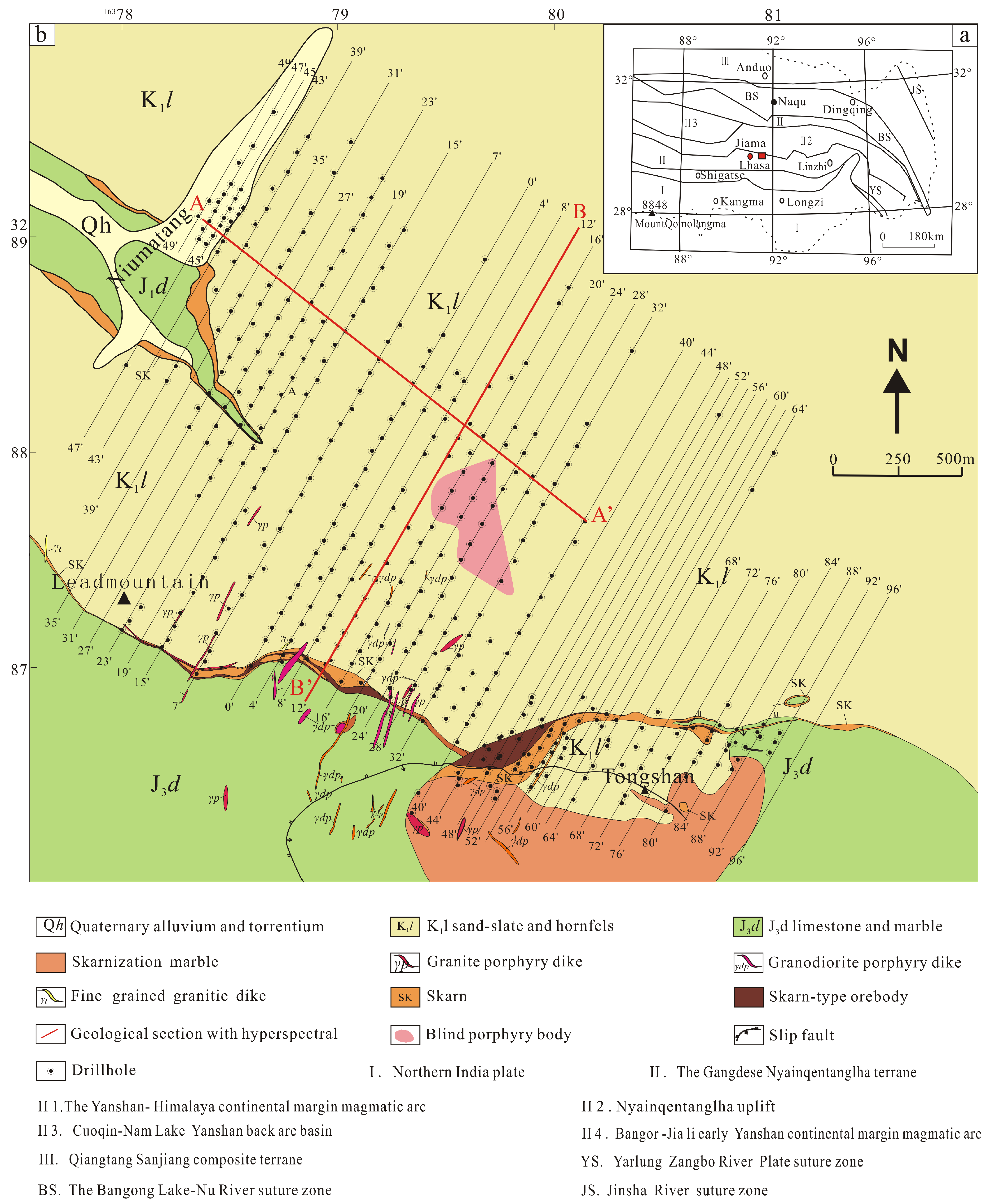
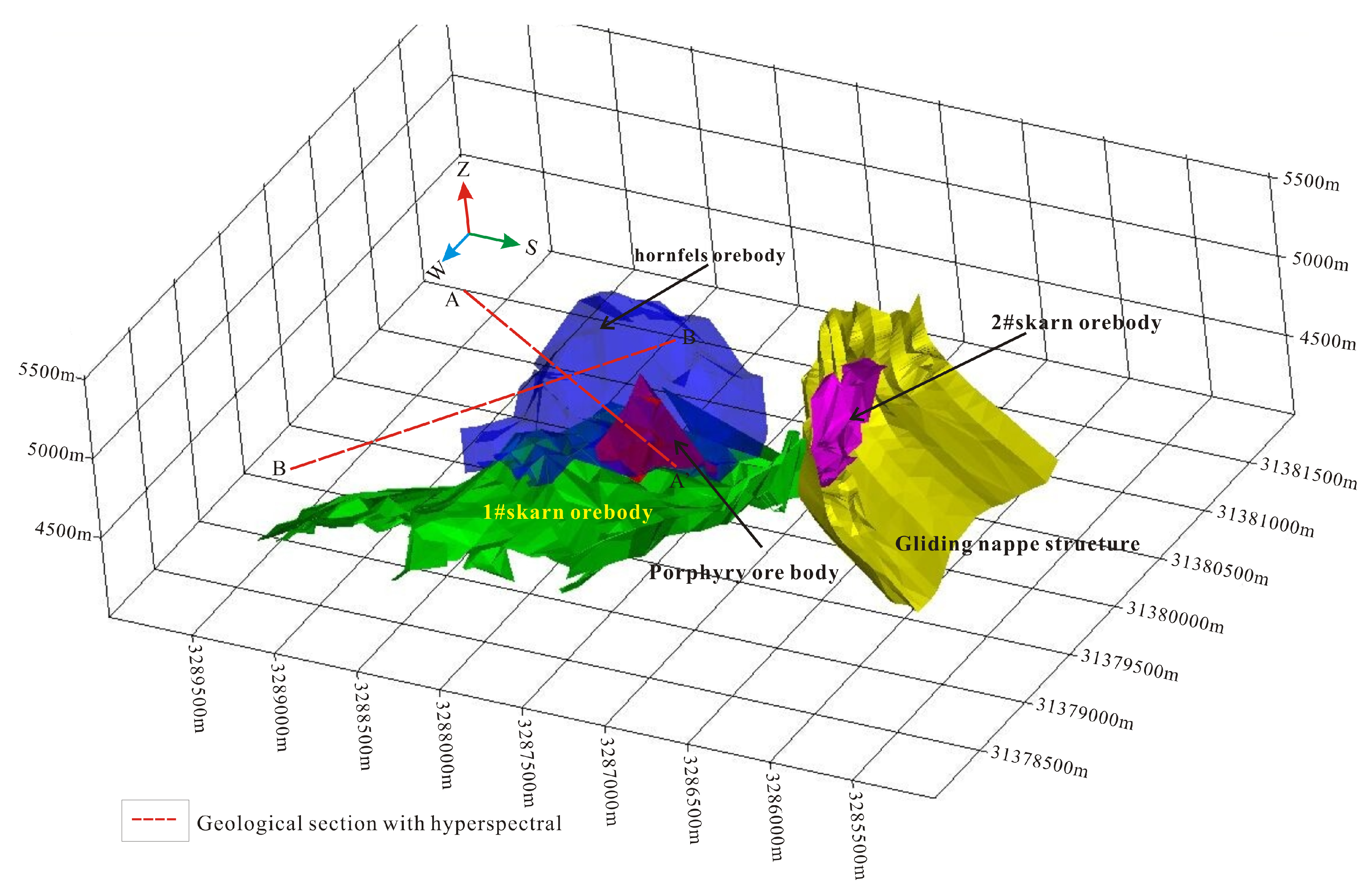
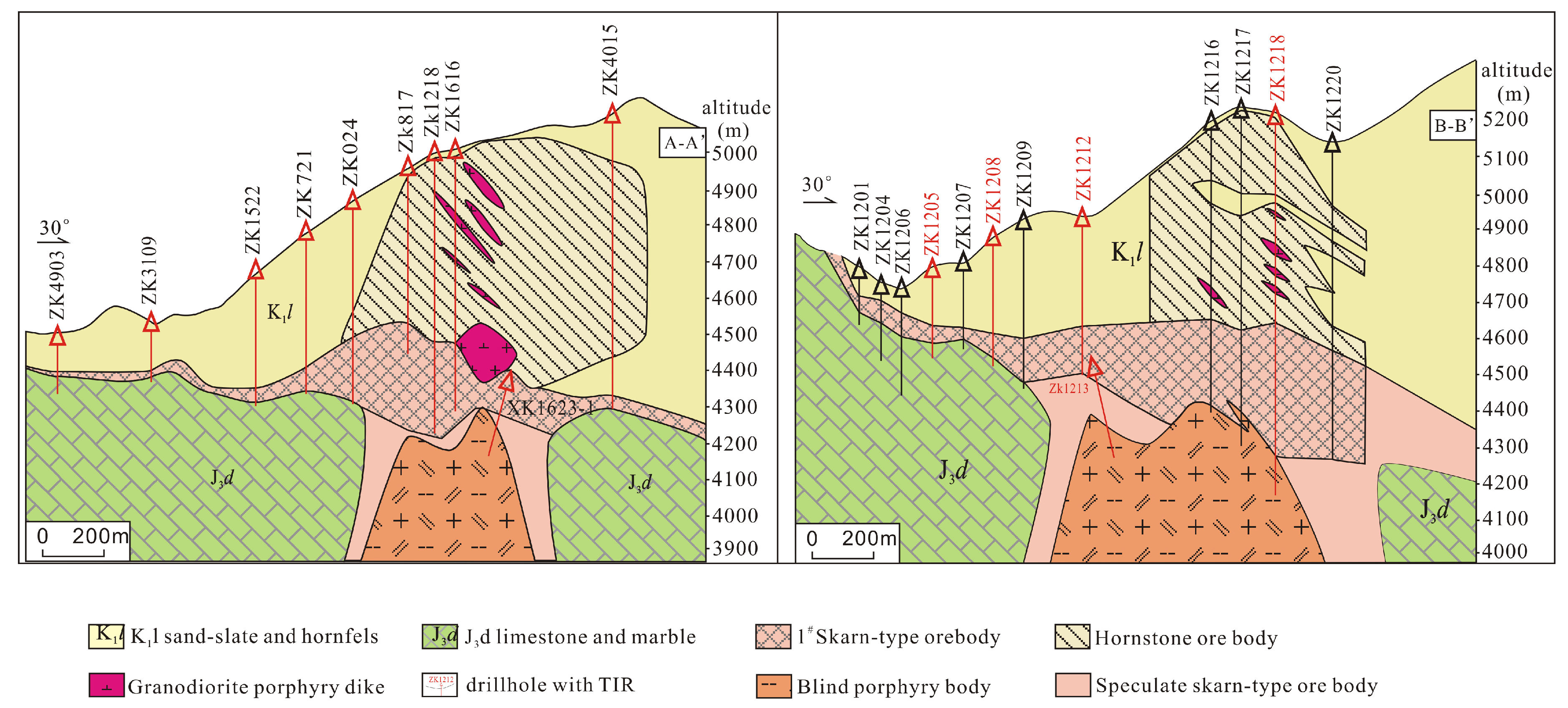

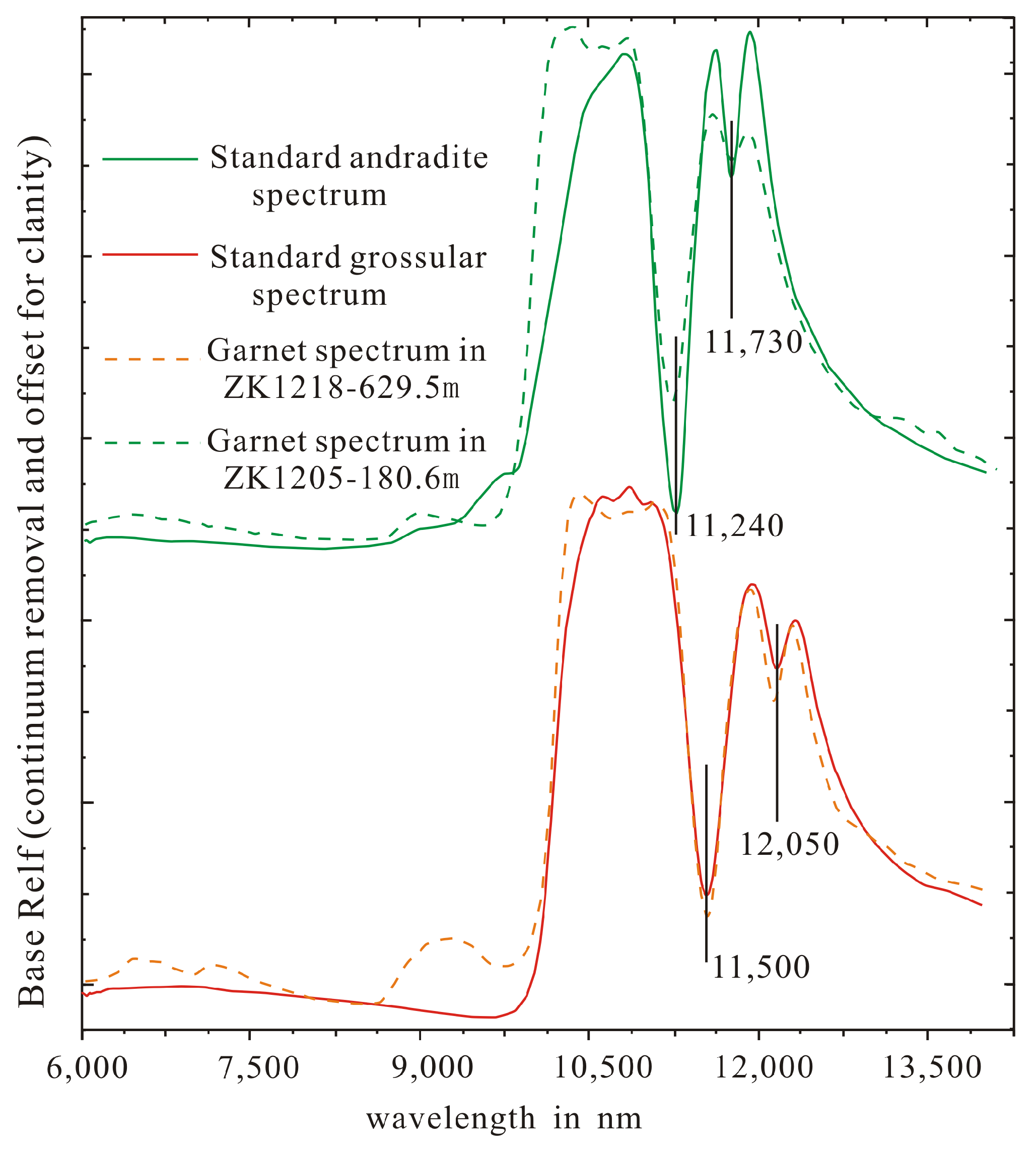

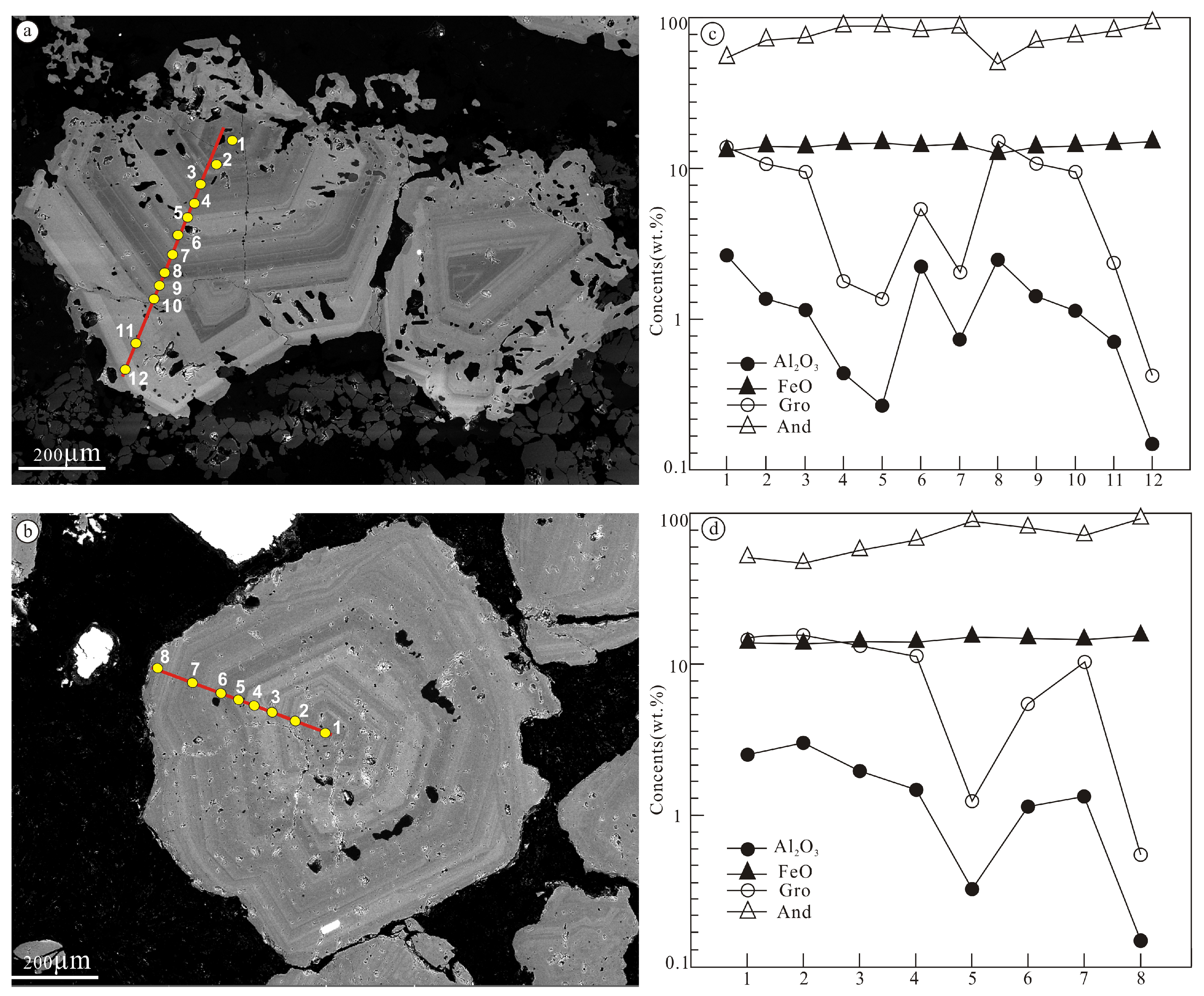
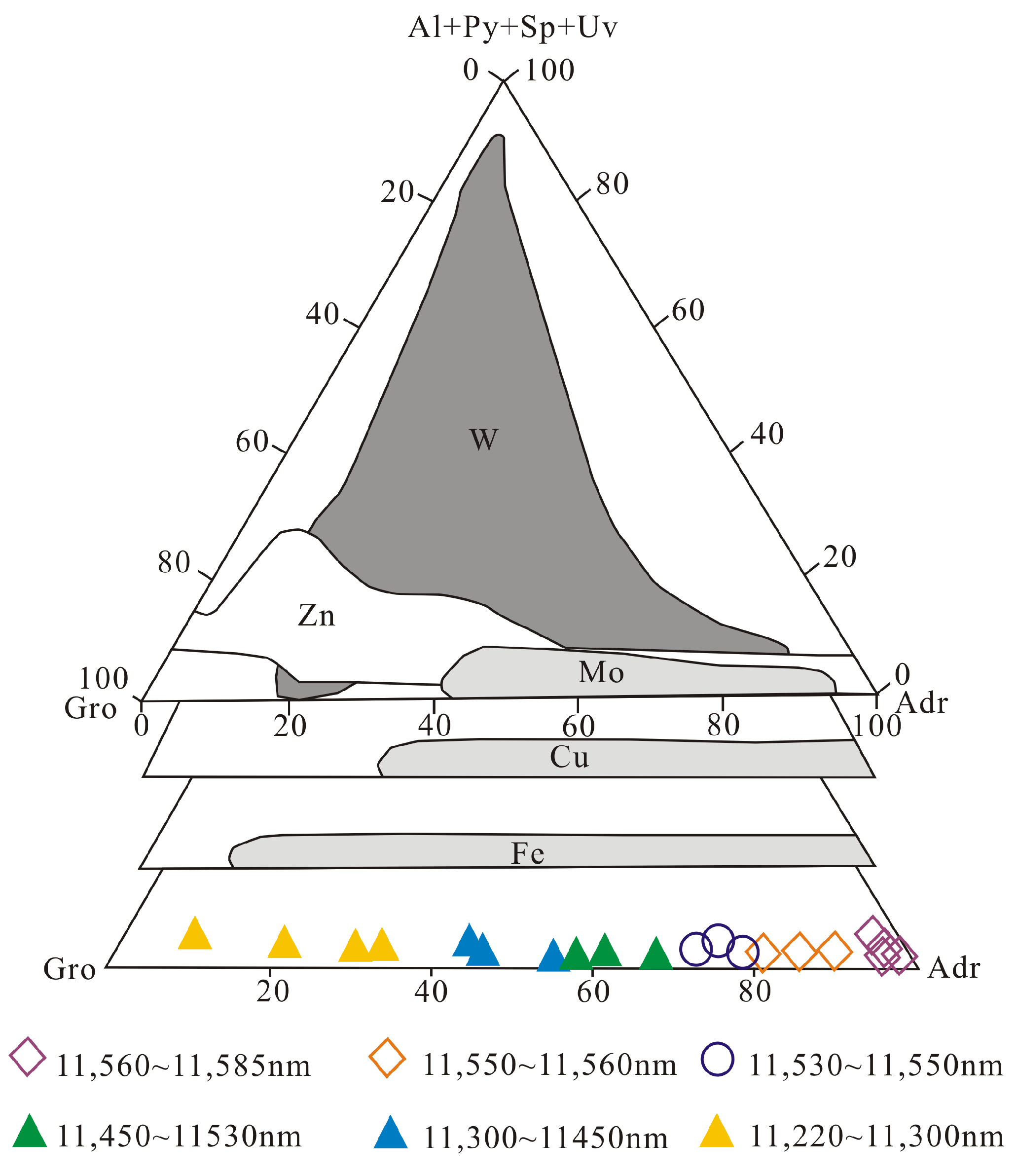
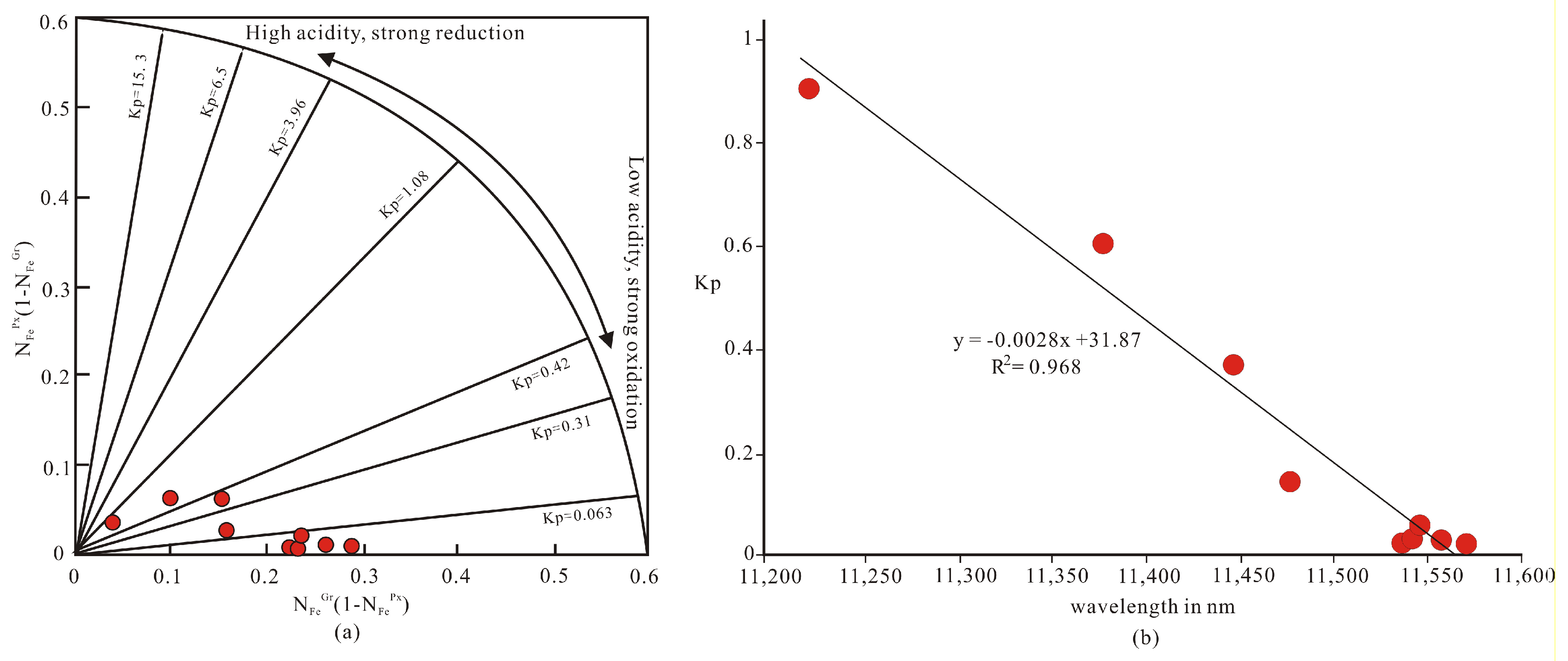

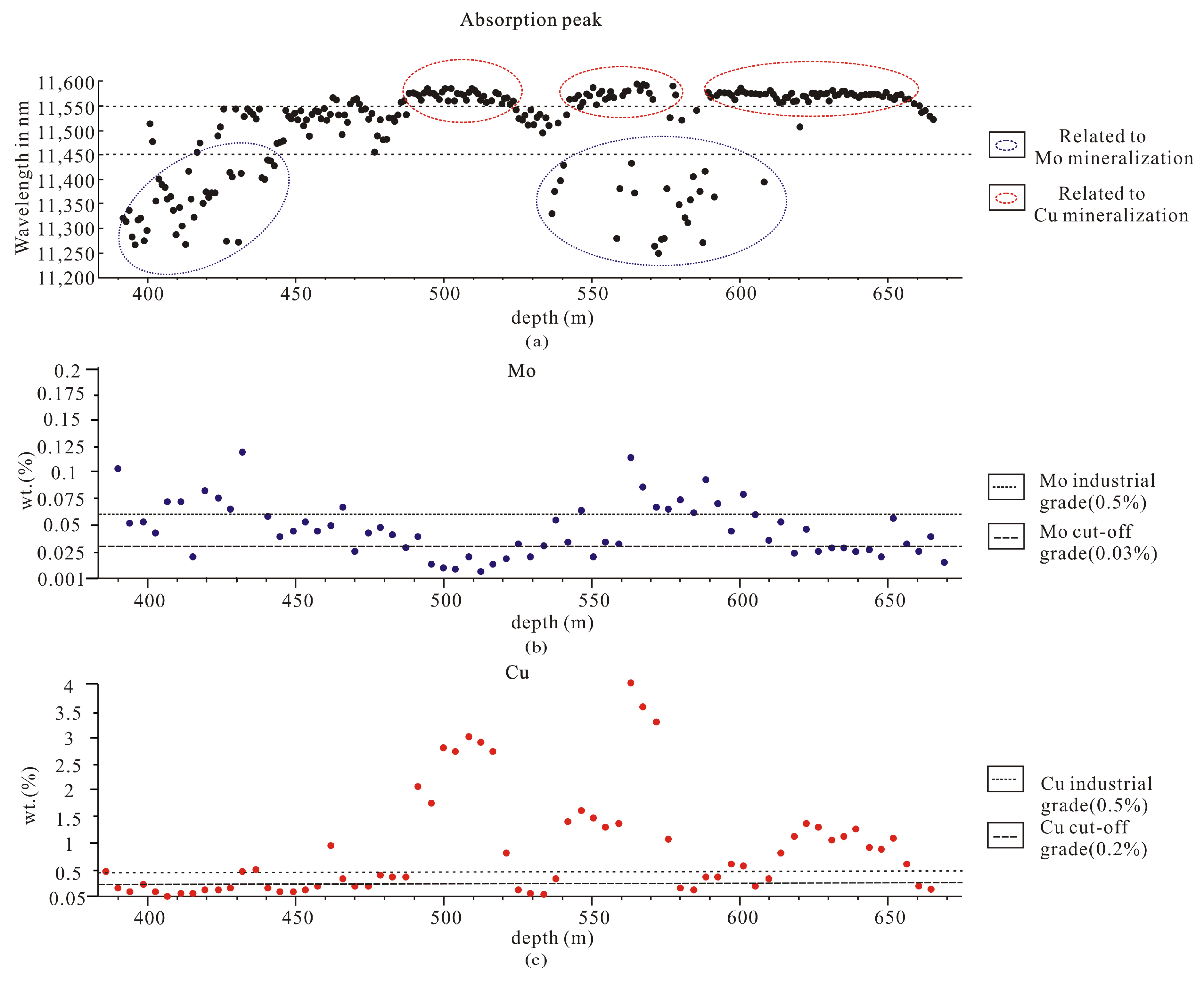

| Colour | Absorption Peak Position |
|---|---|
| Dark brown, black green | 11,560–11,585 nm |
| Brown, brown yellow, reddish brown | 11,530–11,560 nm |
| Emerald green, brown black | 11,510–11,530 nm |
| Light yellow-green, khaki | 11,450–11,510 nm |
| Light khaki, light brown | 11,220–11,450 nm |
| Sample (Dill Hole-Depth) | ZK1218–619 m a | ZK1616–768 m a | ZK1616–737.6 m a | ZK1616–700.96 m a | ZK817–494 m a | ZK1522–331.5 m a | ZK1616–603.1 m a | ZK3905–152.4 m a |
|---|---|---|---|---|---|---|---|---|
| Absorption peak | 11,575 nm | 11,553 nm | 11,544 nm | 11,498 nm | 11,450 nm | 11,380 nm | 11,310 nm | 11,223 nm |
| SiO2 | 35.73 | 36.27 | 36.25 | 37.29 | 36.54 | 37.72 | 38.76 | 38.33 |
| TiO2 | 0.03 | 0 | 0 | 0.25 | 0.05 | 0.37 | 0.18 | 0.63 |
| Al2O3 | 0.1 | 2.58 | 4.1 | 6.83 | 8.88 | 11.08 | 16.84 | 18.45 |
| Cr2O3 | 0 | 0.04 | 0 | 0 | 0 | 0.03 | 0.04 | 0.06 |
| FeO | 28.67 | 25.18 | 22.67 | 19.26 | 17.23 | 14.18 | 7.07 | 3.89 |
| MnO | 0.39 | 0.24 | 0.27 | 0.27 | 0.52 | 0.44 | 0.61 | 0.8 |
| MgO | 0.07 | 0.12 | 0.04 | 0.33 | 0.01 | 0.12 | 0.26 | 0.1 |
| CaO | 33.7 | 34.26 | 34.37 | 34.93 | 34.95 | 35.48 | 35.93 | 36.63 |
| Total | 98.69 | 98.69 | 97.7 | 99.16 | 98.18 | 99.42 | 99.69 | 98.89 |
| Si | 2.97 | 2.98 | 2.99 | 3 | 2.96 | 2.98 | 2.98 | 2.96 |
| Ti | 0 | 0 | 0 | 0.01 | 0 | 0.02 | 0.01 | 0.04 |
| Al | 0.01 | 0.25 | 0.4 | 0.65 | 0.85 | 1.03 | 1.53 | 1.68 |
| Cr | 0 | 0 | 0 | 0 | 0 | 0 | 0 | 0 |
| Fe3+ | 2 | 1.73 | 1.57 | 1.29 | 1.17 | 0.94 | 0.45 | 0.25 |
| Fe2+ | 0 | 0 | 0 | 0 | 0 | 0 | 0 | 0 |
| Mn | 0.03 | 0.02 | 0.02 | 0.02 | 0.04 | 0.03 | 0.04 | 0.05 |
| Mg | 0.01 | 0.01 | 0 | 0.04 | 0 | 0.01 | 0.03 | 0.01 |
| Ca | 3.01 | 3.02 | 3.04 | 3.01 | 3.03 | 3 | 2.96 | 3.03 |
| Andradite | 98.42 | 85.18 | 76.65 | 63.34 | 57.04 | 46.13 | 22.5 | 12.18 |
| Grossular | 0.39 | 13.66 | 22.58 | 34.78 | 41.79 | 52.36 | 75.08 | 85.58 |
| Almandine + Pyrope + Spessartine | 1.19 | 1.04 | 0.77 | 1.87 | 1.18 | 1.43 | 2.32 | 2.07 |
| Samples | ZK1213–70–1 | ZK1213–70–2 | ZK1213–70–3 | ZK1213–70–4 | ZK1213–70–5 | ZK1213–70–6 | ZK1213–70–7 | ZK1213–70–8 |
| SiO2 | 36.36 | 36.32 | 37.12 | 36.94 | 36.85 | 37.04 | 36.48 | 36.8 |
| TiO2 | 0.01 | 0 | 0 | 0 | 0 | 0 | 0.01 | 0 |
| Al2O3 | 3.93 | 2.12 | 1.65 | 0.66 | 0.5 | 1.41 | 0.92 | 4.68 |
| Cr2O3 | 0 | 0 | 0 | 0 | 0 | 0.03 | 0 | 0 |
| FeO | 21.39 | 24.25 | 22.78 | 24.76 | 25.15 | 23.4 | 24.87 | 19.31 |
| MnO | 0.44 | 0.21 | 0.25 | 0.26 | 0.25 | 0.47 | 0.56 | 0.42 |
| MgO | 0.12 | 0.15 | 0.03 | 0.03 | 0.01 | 0.04 | 0.02 | 0.16 |
| CaO | 34.89 | 34.12 | 34.93 | 34.96 | 34.88 | 34.48 | 34.84 | 34.78 |
| Total | 97.14 | 97.05 | 96.8 | 97.61 | 97.64 | 96.85 | 97.68 | 96.16 |
| Si | 3.04 | 3.07 | 3.13 | 3.11 | 3.1 | 3.13 | 3.07 | 3.09 |
| Ti | 0 | 0 | 0 | 0 | 0 | 0 | 0 | 0 |
| Al | 0.41 | 0.22 | 0.17 | 0.07 | 0.05 | 0.15 | 0.1 | 0.49 |
| Cr | 0 | 0 | 0 | 0 | 0 | 0 | 0 | 0 |
| Fe3+ | 1.3 | 1.42 | 1.41 | 1.5 | 1.52 | 1.43 | 1.51 | 1.2 |
| Fe2+ | 0.2 | 0.3 | 0.19 | 0.23 | 0.23 | 0.22 | 0.24 | 0.16 |
| Mn | 0.03 | 0.02 | 0.01 | 0.01 | 0.02 | 0.03 | 0.04 | 0.03 |
| Mg | 0.02 | 0.01 | 0 | 0 | 0 | 0.01 | 0 | 0.02 |
| Ca | 3.13 | 3.09 | 3.15 | 3.16 | 3.15 | 3.12 | 3.15 | 3.13 |
| Andradite | 76.95 | 87.04 | 89.54 | 95.86 | 96.86 | 91.06 | 94.32 | 72.15 |
| Grossular | 1.2 | 12.26 | 9.51 | 3.24 | 2.23 | 7.3 | 3.96 | 25.83 |
| Almandine + Pyrope + Spessartine | 1.84 | 0.69 | 0.93 | 0.9 | 0.9 | 1.64 | 1.72 | 2 |
| Sample | ZK1213–70–9 | ZK1213–70–10 | ZK1213–70–11 | ZK1213–70–12 | ZK024–515–1 | ZK024–515–2 | ZK024–515–3 | ZK024–515–4 |
| SiO2 | 36.31 | 36.49 | 36.36 | 36.44 | 35.68 | 35.6 | 35.73 | 36.9 |
| TiO2 | 0 | 0 | 0 | 0 | 0.05 | 0.04 | 0.04 | 0.62 |
| Al2O3 | 2.27 | 1.65 | 0.87 | 0.25 | 4.62 | 5.21 | 3.85 | 2.57 |
| Cr2O3 | 0 | 0 | 0 | 0 | 0 | 0 | 0 | 0 |
| FeO | 23.48 | 23.01 | 24.65 | 24.98 | 22.33 | 21.42 | 23.19 | 22.9 |
| MnO | 0.48 | 0.37 | 0.25 | 0.23 | 0.19 | 0.19 | 0.18 | 0.17 |
| MgO | 0.02 | 0.03 | 0.03 | 0.03 | 0.22 | 0.23 | 0.21 | 0.15 |
| CaO | 34.43 | 34.96 | 35.2 | 335.54 | 34.63 | 34.35 | 34.23 | 33.9 |
| Total | 97 | 96.51 | 97.38 | 98.36 | 97.73 | 97.04 | 97.44 | 96.67 |
| Si | 3.07 | 3.1 | 3.08 | 3.06 | 2.98 | 2.99 | 3 | 3.11 |
| Ti | 0 | 0 | 0 | 0 | 0 | 0 | 0 | 0 |
| Al | 0.24 | 0.18 | 0.09 | 0.03 | 0.46 | 0.53 | 0.4 | 0.27 |
| Cr | 0 | 0 | 0 | 0 | 0 | 0 | 0 | 0 |
| Fe3+ | 1.4 | 1.44 | 1.52 | 1.58 | 1.29 | 1.24 | 1.34 | 1.35 |
| Fe2+ | 0.25 | 0.19 | 0.22 | 0.24 | 0.27 | 0.26 | 0.29 | 0.27 |
| Mn | 0.03 | 0.02 | 0.02 | 0.02 | 0.01 | 0.01 | 0.01 | 0.01 |
| Mg | 0 | 0 | 0 | 0 | 0.03 | 0.03 | 0.03 | 0.02 |
| Ca | 3.12 | 3.18 | 3.19 | 3.2 | 3.1 | 3.09 | 3.08 | 3.06 |
| Andradite | 86.16 | 89.69 | 94.63 | 98.45 | 73.9 | 70.61 | 77.78 | 84.03 |
| Grossular | 12.34 | 9.06 | 4.44 | 0.69 | 24.53 | 27.78 | 20.7 | 14.68 |
| Almandine + Pyrope + Spessartine | 1.49 | 1.24 | 0.93 | 0.85 | 1.56 | 1.6 | 1.5 | 1.28 |
| Sample | ZK024–515–5 | ZK024–515–6 | ZK024–515–7 | ZK024–515–8 | ||||
| SiO2 | 36.08 | 35.87 | 35.36 | 36.04 | ||||
| TiO2 | 0 | 0.02 | 0.06 | 0 | ||||
| Al2O3 | 0.46 | 1.43 | 2.12 | 0.26 | ||||
| Cr2O3 | 0 | 0 | 0 | 0 | ||||
| FeO | 26.26 | 25.82 | 24.76 | 26.7 | ||||
| MnO | 0.12 | 0.14 | 0.23 | 0.11 | ||||
| MgO | 0.1 | 0.09 | 0.06 | 0.1 | ||||
| CaO | 34.3 | 34.37 | 34.51 | 34.49 | ||||
| Total | 97.32 | 97.74 | 97.1 | 97.7 | ||||
| Si | 3.07 | 3.03 | 3 | 3.06 | ||||
| Ti | 0 | 0 | 0 | 0 | ||||
| Al | 0.05 | 0.15 | 0.23 | 0.03 | ||||
| Cr | 0 | 0 | 0 | 0 | ||||
| Fe3+ | 1.56 | 1.51 | 1.47 | 1.59 | ||||
| Fe2+ | 0.31 | 0.32 | 0.29 | 0.31 | ||||
| Mn | 0.01 | 0.01 | 0.02 | 0.01 | ||||
| Mg | 0.01 | 0.01 | 0.01 | 0.01 | ||||
| Ca | 3.13 | 3.11 | 3.14 | 3.14 | ||||
| Andradite | 97.15 | 91.36 | 87.4 | 98.4 | ||||
| Grossular | 1.95 | 7.76 | 11.65 | 0.75 | ||||
| Almandine + Pyrope + Spessartine | 0.88 | 0.87 | 0.91 | 0.83 | ||||
| Samples (Drill Hole-Depth) | Absorption Peak | Elements (%) | NFeGr | ||||||||
|---|---|---|---|---|---|---|---|---|---|---|---|
| SiO2 | TiO2 | Al2O3 | Cr2O3 | FeO | MnO | MgO | CaO | Total | |||
| ZK4903–153.3 m a | 11,480 nm | 37.92 | 0.07 | 10.19 | 0 | 15.82 | 0.52 | 0.05 | 35.14 | 99.71 | 0.16 |
| ZK3905–152.4 m a | 11,223 nm | 38.33 | 0.63 | 18.45 | 0.06 | 3.89 | 0.8 | 0.1 | 36.63 | 98.89 | 0.04 |
| ZK1522–356.84 m a | 11,540 nm | 36.69 | 0.13 | 4.34 | 0 | 22.2 | 0.16 | 0.12 | 33.62 | 97.26 | 0.23 |
| ZK721–423 m a | 11,548 nm | 36.47 | 0.07 | 4.1 | 0 | 23.22 | 0.28 | 0.04 | 34.18 | 98.36 | 0.24 |
| ZK817–494.3 m a | 11,380 nm | 38.63 | 0.08 | 14.75 | 0 | 9.94 | 0.81 | 0.1 | 36.04 | 100.35 | 0.1 |
| ZK817–515.1 m a | 11,450 nm | 36.87 | 0.88 | 10.38 | 0 | 15.14 | 0.42 | 0.06 | 34.81 | 98.56 | 0.15 |
| ZK817–595.7 m a | 11,558 nm | 36.3 | 0.1 | 2.12 | 0.02 | 25.84 | 0.15 | 0.09 | 33.99 | 98.61 | 0.26 |
| ZK1616–737.6 m a | 11,544 nm | 36.25 | 0 | 4.1 | 0 | 22.67 | 0.27 | 0.04 | 34.37 | 97.7 | 0.23 |
| ZK4015–925 m a | 11,572 nm | 35.75 | 0.04 | 0.26 | 0.06 | 28.67 | 0.27 | 0.09 | 33.94 | 99.08 | 0.3 |
| Samples (Drill Hole-Depth) | Elements (%) | NFePx | ||||||||||
|---|---|---|---|---|---|---|---|---|---|---|---|---|
| SiO2 | TiO2 | Al2O3 | Cr2O3 | FeO | MnO | MgO | CaO | Na2O | K2O | Total | ||
| ZK4903–153.3 m a | 54.77 | 0 | 0.11 | 0.03 | 2.75 | 0.91 | 16.85 | 25.9 | 0.01 | 0.01 | 101.34 | 0.03 |
| ZK3905–152.4 m a | 54.08 | 0 | 0.38 | 0.09 | 3.63 | 1.27 | 16.15 | 25.72 | 0.14 | 0 | 101.46 | 0.04 |
| ZK1522–356.84 m a | 55.31 | 0 | 0.18 | 0 | 0.74 | 0.32 | 18.63 | 25.9 | 0.05 | 0.01 | 101.14 | 0.01 |
| ZK721–423 m a | 54.61 | 0.02 | 0.13 | 0 | 1.74 | 0.72 | 17.8 | 26.03 | 0.09 | 0.02 | 101.16 | 0.02 |
| ZK817–494.3 m a | 53.74 | 0 | 0.25 | 0 | 6.27 | 1.22 | 14.25 | 25.27 | 0.09 | 0 | 101.09 | 0.06 |
| ZK817–515.1 m a | 53.71 | 0.05 | 0.16 | 0.01 | 6.44 | 1.21 | 14.21 | 25.4 | 0.13 | 0 | 101.32 | 0.06 |
| ZK817–595.7 m a | 55.02 | 0 | 0.69 | 0 | 1.05 | 0.51 | 18.5 | 26.32 | 0 | 0 | 102.09 | 0.01 |
| ZK1616–737.6 m a | 54.84 | 0.01 | 0.17 | 0 | 1 | 0.53 | 18.17 | 26.1 | 0 | 0 | 100.82 | 0.01 |
| ZK4015–925 m a | 53.43 | 0 | 0.08 | 2.58 | 1 | 0.54 | 18.03 | 25.38 | 0 | 0.03 | 101.07 | 0.01 |
Publisher’s Note: MDPI stays neutral with regard to jurisdictional claims in published maps and institutional affiliations. |
© 2020 by the authors. Licensee MDPI, Basel, Switzerland. This article is an open access article distributed under the terms and conditions of the Creative Commons Attribution (CC BY) license (http://creativecommons.org/licenses/by/4.0/).
Share and Cite
Huang, Y.-R.; Guo, N.; Tang, J.-X.; Shi, W.-X.; Ran, F.-Q. Garnet Characteristics Associated with Jiama Porphyry-Skarn Cu Deposit 1# Skarn Orebody, Tibet, Using Thermal Infrared Spectroscopy. Minerals 2021, 11, 5. https://doi.org/10.3390/min11010005
Huang Y-R, Guo N, Tang J-X, Shi W-X, Ran F-Q. Garnet Characteristics Associated with Jiama Porphyry-Skarn Cu Deposit 1# Skarn Orebody, Tibet, Using Thermal Infrared Spectroscopy. Minerals. 2021; 11(1):5. https://doi.org/10.3390/min11010005
Chicago/Turabian StyleHuang, Yi-Ru, Na Guo, Ju-Xing Tang, Wei-Xin Shi, and Feng-Qin Ran. 2021. "Garnet Characteristics Associated with Jiama Porphyry-Skarn Cu Deposit 1# Skarn Orebody, Tibet, Using Thermal Infrared Spectroscopy" Minerals 11, no. 1: 5. https://doi.org/10.3390/min11010005
APA StyleHuang, Y.-R., Guo, N., Tang, J.-X., Shi, W.-X., & Ran, F.-Q. (2021). Garnet Characteristics Associated with Jiama Porphyry-Skarn Cu Deposit 1# Skarn Orebody, Tibet, Using Thermal Infrared Spectroscopy. Minerals, 11(1), 5. https://doi.org/10.3390/min11010005




